Nam Sense (19 page)

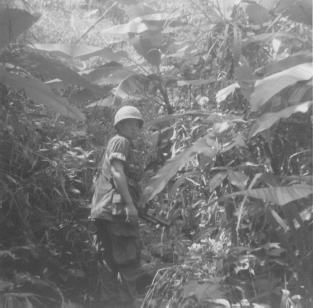
Author
(above) A member of the platoon glances behind him as we carefully investigate an enemy trail in the Annamite jungle mountains five miles northwest of Camp Evans.
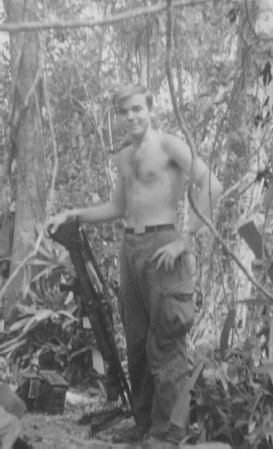
Author
The author poses with an M-60 machine gun on his last day in the field, two days after Howard Siner and Dennis Silig were wounded.
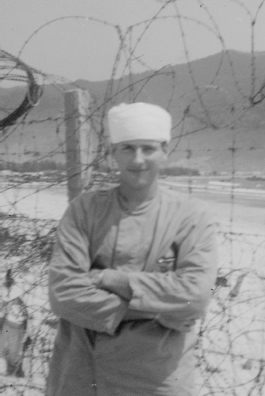
Author
Recovering from his head wound, Howard Siner and the author (below) stand outside the 95th Evacuation Hospital in Da Nang. The barbed wire fence was the only thing that separated the hospital from the ocean.
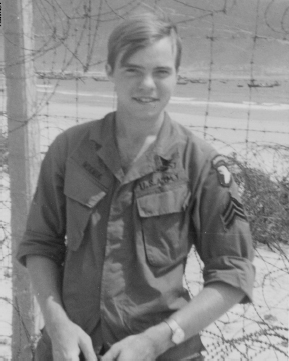
Author
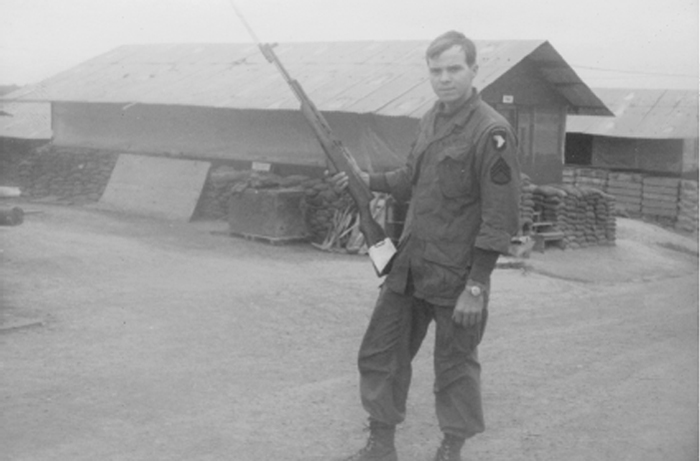
Author
Just days before going home and recently promoted to Staff Sergeant, author poses with SKS rifle at the Camp Evans company area.
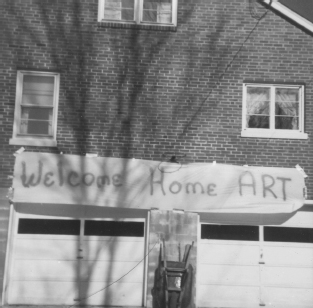
Author
After coming home nine days early, my family hastily made this banner and attached it to our house for all to see. It remained in place for another two weeks.

Arthur Wiknik, Jr., December 2004.
Hitchhiking in Vietnam was an adventure. Although it was officially discouraged, thumbing was an acceptable means of travel. The difficulty was in getting a ride. The Vietnamese would not stop for an American unless money was waved at them, and GIs on the road without a weapon were considered fair game for cowboy ARVN trucker’s to swerve their vehicles at. As a result, only GIs picked up other GIs.
I eventually hitched a ride on a cargo truck going north to Quang Tri. When the truck arrived at the Camp Evans front gate, I asked the driver to bring me the one-half mile to the battalion aid station but he refused. I eventually hobbled the distance on my own.
The aid station medics examining my foot couldn’t believe what they saw. The big toe was pale yellow with a pus-oozing quarter-inch hole on the side. “This is was one of the most advanced cases of immersion foot we have ever seen,” one medic sternly announced.
“We might have to report you for letting it get so bad,” commented the other. “This looks like a self-inflicted injury.”
“I didn’t have the foot treated when I came in from the field because I was afraid that I wouldn’t be allowed to go to Vung Tau,” I said, trying to earn their sympathy.
“That’s bullshit,” the first one scolded. “As soon as we get your treatment started, we’re going to contact your platoon leader to find out what kind of soldier you really are.”
Lucky for me, Doc Meehan was in camp for a first aid refresher course. After I explained the situation to Doc, he got me off the hook by telling to the medics that I was a dedicated Boonie Rat who never complained and always maintained good personal hygiene. Thanks Doc!
I spent the next two weeks at Camp Evans in semi-convalescence. Each morning for an hour, I soaked my foot in a nasty solution that ate away the infection and healed the damaged skin tissues. The toes needed fresh air so I wasn’t allowed to wear boots, which relieved me from work details.
My foot recovery routine included walking a minimum of two miles each day within the confines of Camp Evans. I easily exceeded that requirement to avoid being noticed hanging around the battalion area and giving anyone the idea of putting me to work. At night, I watched movies, played cards, or drank beer at the EM Club. Passing time that way was the dream of everyone in the field.
Grunts coined a name for people in my position: Ghoster. A Ghoster was an infantryman who schemed his way to the rear when he should be in the field. Time spent in the rear was still “good time” and thus counted toward a soldier’s year-long tour of duty. I liked being away from the field, so in the coming months I planned to make ghosting my trademark.
While on the recuperative hikes, I avoided the mud and road dust by cutting between buildings and tents. In so doing, I often discovered hidden details about Camp Evans. Two-hundred feet behind the 18th Surgical Mobile Hospital I encountered a sign reading “Graves Registration: Off Limits.” Graves Registration was the military unit that deals with the processing and embalming of dead American soldiers. The tiny facility was tucked away for good reason: seeing dead comrades was disastrous for troop morale. However, my curiosity drew me in for a closer look. I wish it had not.
The doors were open to a large refrigerated compartment where body bags containing dead GIs lay on racks. They were being kept cold to slow the decomposing process before preparing them for the final journey home. It was depressing to see so many silent body bags in a place with the words “Meat Locker” sloppily painted on the doorway. I stared inside until an Army mortician walked around the corner.
“Hey buddy!” he shouted. “Get out of here! This area is off limits!”
Heading his advice, I turned to leave.
“Not that way!” he shouted again, trying to divert me.
It was too late. At my feet was a dead GI. I surmised he had been alive only a few hours ago. A bloodstained towel covered his face, but the real horror was a gigantic chest wound that completely disemboweled the body. The exposed rib cage was splintered, with each rib grotesquely arching skyward. Only the soldier’s spine held the upper and lower torso together. The mortician, sympathetic to my shock, told me that the GI had taken an RPG to the mid-section.
Looking at a dead Gook did not bother me, but this poor bastard was so mutilated I almost gagged. I supposed his parents did not know yet their son was dead. I thought about my own parents as I softly said, “I’m glad it wasn’t me.” The mortician didn’t respond. He simply motioned for me to leave. I never hiked in that area again.
During my stay at Camp Evans no Grunts came in from the field, so I seldom had anyone to talk to unless it was with the rear echelon soldiers. But the men who worked in the base camp were far different from the Boonie Rats. Grunts called them Rear Echelon Mother Fuckers, or REMF for short. REMFs had logistical jobs such as a cook, trucker, mechanic, or clerk, which kept them from ever having to set foot in the field. They also had access to cold beer and soda, hot meals, showers, laundry, transportation, off-duty hours, radios, and more. A REMF tour was easy compared to that of a Grunt, yet REMFs often complained about how rough and dangerous it was to be in Vietnam, going so far as to retell overheard war stories to raise a level of self-importance to those around him. As near as I could tell, the only danger a REMF faced was from catching gonorrhea or being run down by a drunken truck driver. And the biggest hardship a REMF contended with was when a generator broke down and their beer got warm or there was no movie that night. It was my opinion that the danger a REMF experienced was limited to reading about it in newspapers.
REMFs always steered clear of Boonie Rats. Some did it out of respect because they knew we often dealt with more adversity in a single day than they saw in a year. Others acted out of fear, believing we were gun-toting crazies. Grunts, in turn, avoided REMFs because we thought they were whiners and war hero wannabes who had no idea of the struggles endured in the jungle. As a result, REMFs and Grunts were totally incompatible.
My low opinion of the REMF was confirmed one day as I soaked my foot at the aid station chopper pad. A Chinook set down a cargo net containing the bodies of twenty dead Viet Cong. When the Chinook flew off to refuel, the rotor wash blasted me with a sickening death stench. The dead VC were mostly naked, lying in a gruesome heap with arms and legs protruding through the net. Some bodies were torn apart by shrapnel. Small arms and machine gun fire had killed the others. A few had bullet wounds to the head, which probably meant there were no prisoners taken that day. A ribbon of fluids that oozed from the pile magnified the nauseating image. A few minutes later, three REMFs ran out to the chopper pad with a camera. I watched in disbelief as they took turns climbing atop the grotesque heap to pose for photographs. It was a morbid scene. The trio probably gave no thought as to how many GIs lost their lives for these and other body counts. As they ridiculed the dead with their ghoulish behavior, I wondered how our values could have sunk so low.
The longer I stayed in the rear, the more I became aware of a volatile situation that was beginning to plague the military. It was the growing resentment among some black American soldiers who were not willing to fight in what they called a “white man’s war.” Blacks believed that a disproportionate number of them were being drafted and sent to Vietnam. They also believed that even if they survived Vietnam, it meant facing an on-going war of racial unrest when they get home. Initially, the military dismissed their bitterness and frustration, labeling it the whining of malcontents. That is, until there was a riot at the Long Binh Jail, the in-country prison for US military criminals. During this revolt blacks took over part of the stockade. The result was the death of several GIs. There was also an incident at Da Nang’s China Beach that almost resulted in a shoot-out between blacks and whites. These events forced an immediate reassessment of US military policy. As a result, Afro haircuts, Black Power paraphernalia, and more soul music were allowed. Some bases even offered black awareness classes, but this wasn’t always enough.
Tensions mounted as militant black infantrymen were sent in from the field to face disciplinary action for refusing to fight or obey orders. As a show of solidarity, blacks banded together to form the Camp Evans Black Coalition. The coalition claimed it was not opposed to the war, just to fighting in it. I was especially disappointed to learn that while I was away on R & R, my friend Lennie Person had joined them. I had to ask him why.
“What are you doing with these guys? You don’t belong with them; you’re a Grunt; you’re one of us.”
“Not anymore,” he announced defiantly. “I refused to put my life on the line by walking point and I refused to carry extra ammo for the machine gun. I’m not going to help the white military establishment win the war with my blood. So now the Army has threatened to court martial me.”
“Well, what did you expect?” I asked in disbelief. “Everyone takes turn walking point, even me. And we all carry M-60 ammo for extra firepower. Out in the field everyone’s supposed to be on the same team.”
“Yeah, the white man’s team,” he sneered. “You must have forgot that I’m black.”
“Man, your color means nothing to me. Just look at the things we’ve been through, like Hamburger Hill and the A Shau Valley. We did them together and we helped each other stay alive. But now, I don’t know you. You’ve allowed yourself to be brainwashed.”
“This problem is bigger than you and me. If the Army wants to court martial us because we’re taking a stand against years of white oppression, then let them. But everyday there’s going to be more Blacks rebelling and they can’t lock us all up.”
“Lennie, I may not feel the same things you do, but this way isn’t right. The Army is going to lock you up for disobeying orders, not for your political beliefs or your skin color.”
Lennie did not waiver. Instead, he tried a different approach. “Why don’t you meet some of my new friends? They’re not as bad as you might think.”
He took me to the coalition’s all-black hooch. I was speechless upon walking through the door. A black light illuminated glowing tapestries adorning the walls and ceilings. Several read “Black Power” and “Black Is Beautiful,” while another read “Violence If Necessary, Peace If Possible.” Some tapestries had images of Martin Luther King, Jr., Malcolm X, and members of the Black Panthers. On a bunk, two black GIs practiced the attention getting “dap” greeting, involving a complex routine of hand slapping, gripping, and fist contact. Many blacks claimed the dap was a display of recognition and unity rather than a gesture of defiance. But when I walked into the hooch, the dap abruptly stopped as one of them raised a clenched fist.
“Power to the people!” he shouted. Others quickly muttered, “Right on Brother.” That’s when I knew it was time to leave. I walked out, leaving them to their self-imposed isolation. I had little sympathy for their position, especially knowing that our company had more blacks in the rear than in the field. As a result, I felt a renewed respect for blacks like Freddie Shaw who stayed in the boonies and refused to blame whites for the problems of society. Those men should be especially proud of their military service.

When my case of immersion foot finally healed I returned to the field. It was almost a relief to be back with my friends and away from the nonsense in the rear. When the supply chopper brought me out, Siner announced my return.
“Hey everybody, look who’s back!” he yelled with a big grin. “It’s Sergeant Wiknik, the only Grunt who can stretch a three-day R & R into three weeks!”
“Alright, alright,” I said, defending myself against his playful ribbing. “If you must know, the Army kept me in the rear to see if a Grunt could handle becoming a REMF. I failed.”
“You’d make a great REMF,” added Silig. “If you could drink more than two beers in one sitting. So why did you come back, did you get tired of watching the same movies?”
“Very funny. I came back because I miss the thrill of getting shot at.”
“I hate to disappoint you,” Stan Alcon chimed in, “but it’s been pretty quiet while you were gone. No enemy contact and very few booby traps. The only thing we’ve been doing is ambushing VC trails, but nobody ever shows up!”
“Cut the reunion chi-chat!” barked Sergeant Krol. “We’re moving out in five minutes!”
All conversation abruptly stopped as the men dejectedly glanced at each other. It was obvious that Krol had not eased up while I was gone. We put our gear together and moved out, following a trail until it eventually intersected with another. Krol and Lieutenant Petry decided it made for a perfect ambush site because the surrounding thick brush would funnel any VC traffic into an escape-proof ground zero.
One trail led north past an abandoned French fort, where Krol positioned his ambush team behind a natural berm. The other trail crossed a shallow slow-moving stream where a second team positioned themselves. A third team retreated two hundred feet back on the route we walked in from in case we were followed. Krol placed my team where the trail crossed the stream, making us the hub position of the other teams. It seemed like an odd location because the only way the VC could get near us was if they walked past or shot their way through one of the other teams. We were also in a dangerous position if any of the ambushes were sprung because friendly fire could be shot in our direction. I didn’t like the set up, but since there had been no enemy activity for several weeks, I didn’t question anything.